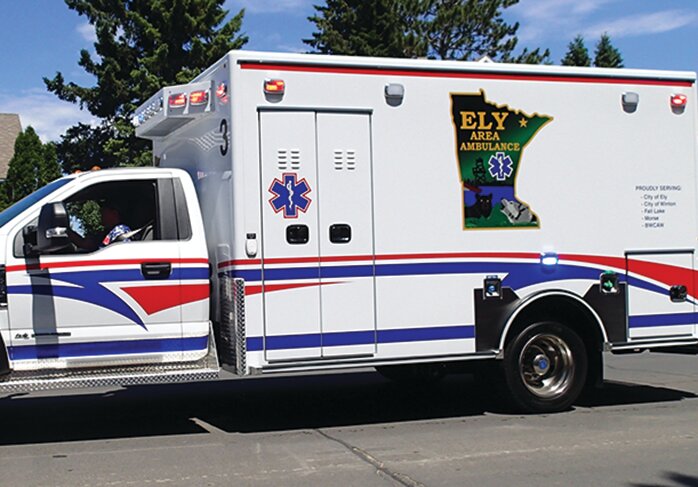Support the Timberjay by making a donation.
Hauschild amendment boosts funds for area EMS
REGIONAL— Ambulance services in greater Minnesota will see significant financial assistance beginning later this year as a result of final passage of an amendment authored by Sen. Grant …
This item is available in full to subscribers.
Attention subscribers
To continue reading, you will need to either log in to your subscriber account, below, or purchase a new subscription.
Please log in to continue |
Hauschild amendment boosts funds for area EMS

REGIONAL— Ambulance services in greater Minnesota will see significant financial assistance beginning later this year as a result of final passage of an amendment authored by Sen. Grant Hauschild, DFL-Hermantown.
Hauschild’s amendment, which provides $24 million in supplemental aid, was part of a broader package of changes to the state’s emergency medical system approved by the Legislature. “Our EMS network is facing a dire financial situation throughout the state, threatening the ability of Minnesotans to get the urgent care they need,” said Hauschild. “This emergency aid is urgently needed to provide an immediate lifeline that will help stabilize EMS and ensure people in communities like the ones I represent and throughout Minnesota continue to get the care they need.”
While the $24 million is substantially less than the $120 million Hauschild had originally proposed, he noted that the original funding proposal included money for ambulance services across the state, including the metro region. While the funding is now less, Hauschild said it’s much more targeted to assist smaller services in rural Minnesota. The funding amounts in the new law are based on a point system determined by the number of EMS responses qualified services undertake and other factors, and the formula is going to direct significant new one-time resources to area ambulance services (see accompanying sidebar), ranging from $264,384 for Ely to $114,140 for Cook. Tower is slated to receive $123,957, while $160,177 is earmarked for Orr.
Tower Ambulance Director Dena Suihkonen said she liked the point system, which favors the smallest ambulance services. “It’s focused on the ones that are bleeding right now,” she said. “That means we will get real help up here.”
While the one-time supplemental aid will help, Hauschild acknowledges it’s not the final answer. “We all know that this is only a band-aid and that over the long term we must find a sustainable funding model for EMS services,” he said. “This influx of aid and the important changes we are making to our EMS system are vital steps forward, but I will continue to push for robust investment that will ensure the long-term stability of EMS in Minnesota.”
Most ambulance services in northern St. Louis County have been reporting sizable financial losses in recent years and that has forced many small cities and townships to backfill funding gaps to maintain the critical service.
The new EMS law, which was given final passage early last Saturday morning, also creates the Office of Emergency Medical Services to replace the Emergency Medical Services Regulatory Board, or EMSRB, which has faced criticism for lax management of the state’s ambulance services.
Pilot program
The package also includes $6 million to fund a “sprint medic” pilot program in St. Louis County as well as two west-central Minnesota counties. The pilot program is designed to test the effectiveness of using roving paramedics who would operate across the boundaries of up to several ambulance coverage areas and would respond in personal vehicles to medical calls, in hopes of improving response time and the level of care that can be provided to patients at the outset of that response. Paramedics are more highly trained than Emergency Medical Technicians, or EMTs, and can administer more medications, insert breathing tubes, and establish intravenous lines.
The sprint medics would likely be deployed in various places day-to-day depending on which area ambulance services are facing staffing shortages. Depending on the calls, they could perform a variety of functions, potentially assessing patients before ambulances arrive, or accompanying patients to the hospital if a transport is needed.
Depending on the type of 911 call, a sprint paramedic might be sent first to assess a patient, or at the same time as a single EMT in the nearest ambulance. If a transport to a hospital is needed, the paramedic would leave the sprint vehicle behind and monitor the patient during the ambulance ride. In some cases, the paramedic could handle treatment on scene and keep ambulances with advanced-life support equipment from being dispatched unnecessarily.
Suihkonen said she saw the sprint medics as a way to provide advanced life support, or ALS, intercepts without having to engage the Virginia ambulance. “To me that would be huge,” she said. “It would almost double the availability of ALS intercepts.” The medics would be deployed to ride along with an ambulance and could provide ALS care along the way to the hospital.
The sprint medic concept has been shown to be effective in more urbanized areas but whether they are practical in lightly populated regions, like northern St. Louis County, remains to be determined.
Estimated Funding Amounts
Babbitt - $106,790
Bigfork - $150,894
Bois Forte - $65,729
Cook - $114,140
Hoyt Lakes - $163,447
Int’l Falls - $207,794
Grand Portage - $43,971
Gunflint Trail - $74,843
Lake County - $314,334
Littlefork - $202,447
Orr - $160,177
Tower - $123,957
Cook County - $195,556
Ely - $264,384
Blackduck - $226,083
Essentia EMS - $1,040,246






